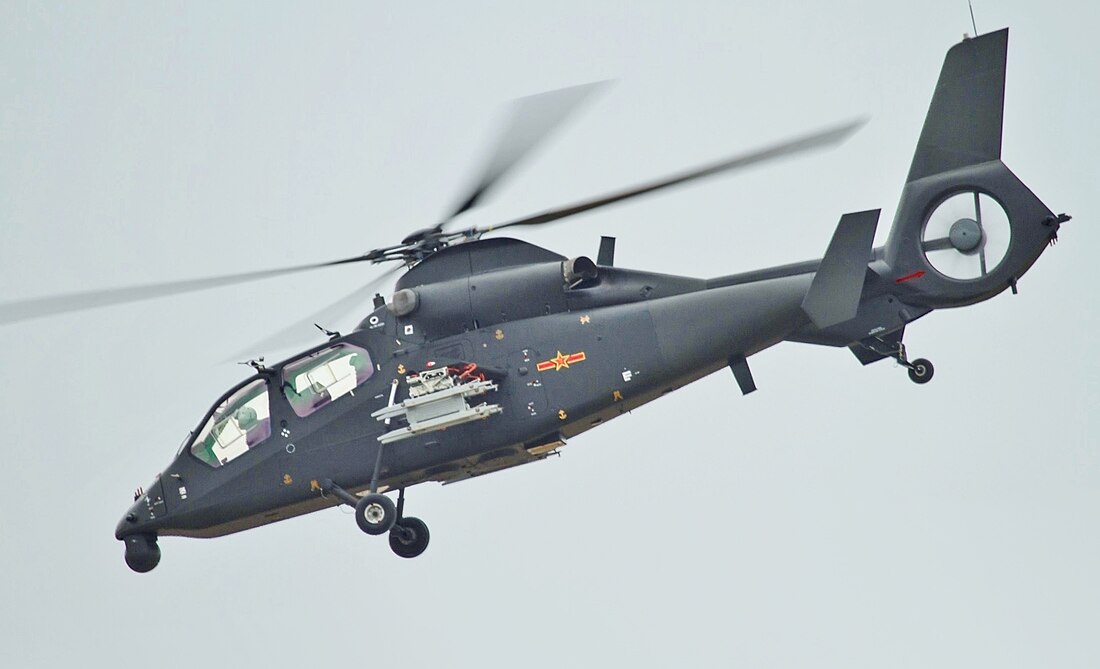Top Qs
Timeline
Chat
Perspective
Harbin Z-19
Chinese reconnaissance and attack helicopter From Wikipedia, the free encyclopedia
Remove ads
The Harbin Z-19 is a Chinese light reconnaissance/attack helicopter developed by Harbin Aircraft Manufacturing Corporation (HAMC) for the People's Liberation Army Air Force and the Ground Force Army Aviation.[3] It is a specialized combat variant of the Harbin Z-9, which is a license-built version of the Eurocopter Dauphin.[4]
Remove ads
Design and development
Summarize
Perspective
The Z-19 is an upgraded tandem seat version of the Harbin Z-9W (similar to the development of the Bell AH-1 Cobra from the UH-1), using mechanical components derived from the Eurocopter AS365 Dauphin series, as the Z-9 series are license-built versions of the Dauphin helicopters.[4]
The Z-19 features a fenestron tail, reducing the noise level and therefore allowing it to achieve some level of acoustic stealthiness. The exhausts have also been designed to reduce the infrared signature.[5] The helicopter is equipped with a millimeter-wave fire-control radar on top of its four-blade rotor.[6] Unlike most other attack helicopters, it lacks a nose-mounted machine gun or autocannon.
The Z-19 also features armor plating, crash-resistant seats, and a turret with FLIR, TV, and laser rangefinder.[5] It is also equipped with advanced helmet mounted sight (HMS),[7] which looks different from that of the CAIC Z-10.
The general designer of the Z-19 was Wu Ximing (吴希明) of the 602nd Research Institute, one of the Chinese top scientists involved in the 863 Program, after graduating from Nanjing University of Aeronautics and Astronautics in 1984. Wu had earlier participated in the designs of the armed version of the transport helicopters Z-8A, Z-11 and Z-9. He also participated in the development and flight testing of another Chinese attack helicopter, the CAIC Z-10. At the 9th Zhuhai Airshow held in November 2012, Aviation Industry Corporation of China formally announced the official names of the Z-10 and Z-19 at a televised news release conference, with both attack helicopters named after fictional characters in the Water Margin, one of the Four Great Classical Novels of Chinese literature. Z-10 is named as Fierce Thunderbolt (Pili Huo, 霹雳火), the nickname of Qin Ming, while Z-19 is named as Black Whirlwind (Hei Xuanfeng, 黑旋风), the nickname of Li Kui.[8][9]
Remove ads
Variants
Operators
Specifications (Z-19)

Data from [citation needed]
General characteristics
- Crew: Two, pilot and observer
- Length: 12 m (39 ft 4 in)
- Height: 4.01 m (13 ft 2 in)
- Empty weight: 2,350 kg (5,181 lb)
- Max takeoff weight: 4,250 kg (9,370 lb)
- Powerplant: 2 × WZ-8C turboshafts, 700 kW (940 hp) each
- Main rotor diameter: 11.93 m (39 ft 2 in)
- Main rotor area: 111.79 m2 (1,203.3 sq ft)
Performance
- Maximum speed: 280 km/h (170 mph, 150 kn)
- Cruise speed: 245 km/h (152 mph, 132 kn)
- Range: 700 km (430 mi, 380 nmi)
- Endurance: 4 hours
- Service ceiling: 6,000 m (19,685 ft)
- Rate of climb: 9 m/s (1,800 ft/min)
Armament
- 2 pylons for rockets, gun pods, cannon pods, 8× HJ-8 or other anti-tank/air-to-surface/anti-ship missiles, 8× TY-90 air-to-air missiles.[5]
Avionics
- Unknown type millimeter-wavelength electronically scanned array radar
Remove ads
See also
Related development
Aircraft of comparable role, configuration, and era
- Agusta A129 Mangusta
- Bell AH-1Z Viper
- Boeing–Sikorsky RAH-66 Comanche
- CAIC Z-10
- Denel Rooivalk
- Eurocopter Tiger
- HAL Prachand
- IAIO Toufan
- Kamov Ka-50
- Kawasaki OH-1
- Mil Mi-28
- Panha 2091
- TAI/AgustaWestland T129
Related lists
References
External links
Wikiwand - on
Seamless Wikipedia browsing. On steroids.
Remove ads

